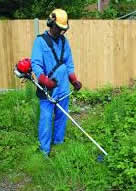Vibration - Control of Vibration in the Workplace
What is Vibration?
Human vibration is defined as the effect of mechanical vibration of the environment on the human body - the vibration transmits into, and through our bodies. During our normal daily life, we are exposed to various sources of vibration, for example, when travelling on the bus. In addition, some of us are exposed to vibration during our working day, this associated with the equipment used. For example, mowers, chainsaws and percussion tools.
How can it affect health?
Regular exposure to significant levels of vibration can impact on the body through:
-
Hand-arm Vibration (HAVs) - a painful and disabling condition that affects the nerves, blood vessels, muscles and joints of the hands and arms. It causes tingling and numbness in the fingers, reduces grip strength and the sense of touch, and affects the blood circulation (vibration white finger, also known as VWF). NOTE: In recognition of the types of hand held work equipment used by some staff, the University has a specific Control of Hand Arm Vibration Policy.
-
Whole-body Vibration (WBV) - associated mostly with low back pain, although acknowledged back pain is attributable to other factors, for example, manual handling, so vibration will not necessarily be the cause.
The risk depends on the magnitude of the vibration and how long an individual is exposed. Other aspects that can have an affect are other forces applied at the time e.g. gripping, pushing, the pattern of exposure, how much of the body is exposed and temperature. Smoking habits and individual susceptibility can also play a part.
Legislation
The Control of Vibration at Work Regulations 2005 require employers to protect against risks to health from vibration at work. The Regulations detail a range of requirements, including the introduction of an Exposure Action Value (EAV) and Exposure Limit Value (ELV), based on an 8-hour working day, which must be adhered to.
|
Hand-arm Vibration |
Whole-body Vibration |
ACTION VALUE (EAV) is the daily amount of vibration exposure above which employers must take action to reduce exposure. |
2.5 m/s2 A (8) |
0.5 m/s2 A (8) |
LIMIT VALUE (ELV) The maximum amount of vibration an employee may be exposed to on any single day, and which must not be exceeded. |
5.0 m/s2 A (8) |
1.15 m/s2 A (8) |
University Policy – Hand Arm Vibration
At the University Campus Services and science based Colleges have staff who routinely operate hand held vibrating tools and equipment as part of their work. As such the University has the specific Control of Hand Arm Vibration Policy which details the core requirements to comply with the Regulations.
General Requirements
Except for the provision of an Occupational Health Service which the University ensures, Colleges and Services must implement all other aspects as part of the day-to-day management of health and safety risks associated with their activities:
-
Carry out a suitable and sufficient risk assessment using the Health and Safety Executive’s Vibration Exposure Calculator and the HSE Ready Reckoner (‘points’ system) to assess the level of exposure.
-
Document the controls needed to ensure the health and safety of those at ‘particular risk,’ developing safe systems of work and procedures as necessary.
-
Communicate the findings of risk assessments and control measures and safe systems of work, to staff.
-
Arrange Health Surveillance for staff ‘at particular risk,’ both existing and new staff.
-
Provide suitable training, instruction and information to all relevant staff and students.
-
Purchase/hire equipment with the lowest vibration level, where practicable.
-
Set up systems to ensure vibratory hand tools and equipment are maintained, with defective equipment removed from use until remedial work is undertaken.
-
Provide appropriate Personal Protective Equipment (PPE) e.g. gloves to keep hands warm.
-
Regularly review systems and procedures.
Vibration Exposure Calculators - Assessing EAVs and ELVs
To support the Regulations the Health and Safety Executive (HSE) have several Vibration Exposure Calculators which utilise a point-based system, combining the vibration magnitude and the operating time, to calculate exposure for a range of activities and equipment. These enable Colleges and Services to assess the level of exposure in accordance with the EAV and ELV to identify those at ‘particular risk’ so further action can be established.
Health Surveillance
Following the assessment process, Colleges / Services must notify the Occupational Health Practitioner of staff identified as at ‘particular risk.’ This includes completion of a Tier 1 Pre-exposure Baseline Questionnaire for new staff and a Tier 2 Annual Questionnaire for existing staff. The Occupational Health Practitioner will then undertake Health Surveillance and / or arrange for further, specialist health assessments as required.
Further information regarding this process can be found in the on-line Health Surveillance and Health Monitoring Handbook.
Useful Resources
Hand Arm Vibration
Whole Body Vibration
Health Surveillance
